
The huge equestrian statue in the middle of Milan’s Piazza del Duomo was of Italy’s first king, Victor Emmanuel II. This is where the Milanese come for public spectacles, marches, and protests.
He was looking at the grand Galleria named in his honor that we’d tour soon. Atop the triumphal arch were the words: “To Victor Emmanuel II, from the grateful people of Milan.”
More views of the immense piazza:
Dominating the square was, of course, the Duomo or
Cathedral.
Mussolini made pompous speeches from the balcony of one of the twin fascist-style buildings on the other side of the Duomo.
The relief panels on the buildings showed Milan’s history.
The historic ducal Palazzo Reale was now home to the Duomo Museum with its collection of original art and treasures.
One of the Duomo’s early treasures was the 900-year-old Byzantine cross made of copper but gilded with real gold and nailed onto wood. It had been part of one of the archbishop’s tombs.
A wooden model of the church:
Likely the most unusual mitre we'd ever seen was this Hummingbird one from the third quarter of the 16th century that was made with tropical bird feathers glued onto sisal paper and canvas.
The large room contained a variety of monstrances that showed objects of piety.
The sublime early 15th-century wood carving of Madonna and Child:
The big gilded bust of God the Father was constructed of wood, wrapped in copper, and then gilded. It once covered the keystone connecting the tallest arches above the Duomo’s high altar.
Among the oldest statues belonging to the Duomo was this
600-year-old one of St. George that once stood on the cathedral’s first
constructed spire. Some ponder the face was of the Duke of Visconti who started
the cathedral.
Steven was happy seeing more grotesque gargoyles that used to be attached to the cathedral to scare away evil spirits and drain rainwater away from the building.
Other statues and spires made of marma di Candoglia or Candoglia marble filled the museum as the Viscontis donated their entire Candoglia quarry so the church could use all the marble it would ever need.
Pilgrims could commune with, and be at peace with, the 15th-century statue of St. Paul the Hermit who lived in the desert to be close to God. We could sense his inner richness even though he wore but a simple robe.
The rather effeminate-looking 15th-century man with the contract in his hand was Galeazzo Sforza, Visconti’s descendant, showing the church owning the quarry. By the way, the church still makes money on the quarry!
“The brilliantly gilded and dynamic statue” of God the Father was created in 1554.
In the same room was a sumptuous 15th-century tapestry woven from gold, silver, and silk than hung 500 years ago from the high altar. I liked seeing how details of everyday life had been woven into the story of the Crucifixion and the exquisite details that even included the tears on Mary’s cheeks.
I wish you could have been at our sides to take in this room with 360 degrees of gorgeous 12th to 15th-century stained-glass that told stories of the Creation.
The Tower of Babel …
and David and Goliath.
We were extraordinarily lucky to see these details close up as they were formerly so far above the cathedral floor so they would be closer to God’s eyes only.
This was a copy of the Madonna statue at the top of the cathedral that was over a dozen feet high and weighed a ton.
Tucked away in the former palazzo was the Church of San Gottardo in Corte, a ducal chapel built in 1336 and originally dedicated to the Virgin Mary before honoring St. Gotthard, the patron saint invoked by those with physical ailments.
The fresco was found in 1929 at the base of the bell tower on the wall of a destroyed church. It was detached from the original wall in 1952 and transferred to canvas and placed on the wall.
Back in the museum, a display juxtaposed monochrome paintings from 1628 by Giovanni Battista Crespi with terra-cotta panels. After Crespi had finished his paintings, they were translated into panels before being sculpted into marble to decorate the cathedral’s doorways.
Crespi's Creation of Eve and its terra cotta twin served as the model for the marble statue still above the center door on the Duomo's west side.
The swirling, stone-carved Dancing Angels used to decorate the ceiling over the door.
More stunning Flemish tapestries made us wish we'd been able to view some of them when we were in Brussels at the beginning of the trip.
Statues on shelves packed a warehouse reaching to the ceiling. I wondered when they had last seen the light of day and would again.
1773’s Frame of the Madonnina was described as “standing like a Picasso in its original iron frame” for the Virgin Mary statue that still crowned the cathedral’s tallest spire. A steel replacement was produced in 1967 for the 33 pieces of gilded copper bolted to the frame.
We almost missed seeing the carved-wood face in the corner that was the original mold for Mary’s copper face that crowned the cathedral.
Just before leaving the marvelous museum, we had a better look at the actual wooden 16th-century model of the Duomo used by the architects and engineers to build the church. This version of the façade was changed, however.
Luini's was a great find near Piazza del Duomo for a quick bite to eat.
Next to the Piazza del Duomo was the breathtaking four-story glass-domed Galleria Vittorio Emanuele II, an iron-and-glass shopping mall that was built during the days of Italy’s unification in the 1860s. Designed by Giuseppe Mengoni, the first building in the city to have electric lighting opened a day after he died.
The venerable Bar Camparini was the former haunt of the famous operatic composer Giuseppe Verdi and the conductor Arturo Toscanini who hung out after their performances at the nearby La Scala Opera House. The bar was named after its first owners, the Campari family who originated the famous red Campari bitter drink we saw hundreds of people drinking all over Italy.
The Galleria celebrated the establishment of the new nation as an independent country with patriotic mosaics in its dome symbolizing all the continents except Australia.
Who couldn’t love its mosaic floor with its patriotic white cross in the middle of the king’s coat-of-arms?
A few steps away facing the city of Torino, Italy’s provisional capital from 1861 to 1865, was that city’s symbol, a little bull or torino. Local lore has it that if you spin two times clockwise while stepping on its testicles, you’ll have good luck. Enough people must believe it to cause the mosaic to be replaced every few years!
The she-wolf of Romulus and Remus faced Rome, thereby honoring the city that has been Italy’s capital since 1870s.
Along with all the top Italian brands of Gucci, Prada, and Louis Vuitton, was Borsalino that has been selling hats since the Galleria opened in 1877.
Walking through the delightful Galleria brought us to Piazza del Scala, a pedestrian-only square that was dominated by a statue of Leonardo da Vinci done in 1870. The genius spent the best twenty years of his life in Milan under the patronage of the wealthy Sforza family who dominated Milan as the Medicis did Florence.
The reliefs under the statue depicted his contributions as a painter,
architect and engineer. Da Vinci, sporting a hydro-engineer hat, reengineered Milan’s canal system complete with locks as it was a major port city until the 1920s.
The statue looked toward the famous neoclassical building that was the location of what most people would consider to the world’s most prestigious opera house, Teatro alla Scala, that opened in 1778 with an opera by Antonio Salieri.
Even though neither of us are opera buffs, I think we’d toured all the great and even not-so-great opera houses in the world and didn’t want to miss the grandaddy of them all.
Certainly never saw a bathroom sign like this one before!
Frankly, the La Scala Museum was a low-key and not very impressive affair with paintings and busts of operatic greats like the portly Rossini,
and Verdi with his three loves: two wives and a piano!
examples of antique musical instruments in one room,
and batons belonging to Toscanini, La Scala's great conductor and music director.
In another of the small rooms was a bust of Enrique Caruso who brought Italy’s magic to the United States and ...
singer Maria Callas.
A cast of Chopin’s hands:
We could feel the palpable excitement of the well-dressed opera patrons alighting from their carriage in the 1852 street scene in Milan’s opera heyday.
The glass case held miniature portraits of famous opera singers and composers.
Liszt’s grand piano was still in playing condition!
Another room brought us to the roots of opera in commedia dell’arte with harlequins and buffoonish doctors in masks.
I found the rooms very cramped and missing the elegance I had expected of La Scala. My disappointment washed away upon ascending a staircase and entering the theater itself. How I wished I, too, was wearing a fancy gown like the ladies in the painting we’d just seen, Ellen!
Because of our vantage point, we couldn’t spot the royal box as it was in the center rear. Sitting in the ornate red-velvet seats and gazing into the huge orchestra pit and the massive Bohemian crystal chandelier was a thrill even for non-opera fans like ourselves!
Next post: Piazza dei Mercanti and Milan's oldest museum, the Pinacoteca Ambrosiano.
Posted on November 23rd, 2021, after returning to our home in Colorado from spending the last two plus months in Europe. We can hardly wait to have more of our family fly in from California for the American Thanksgiving holiday in two days.


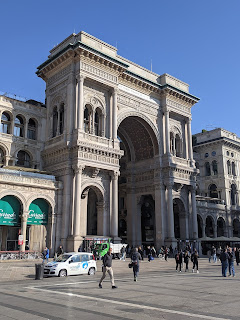


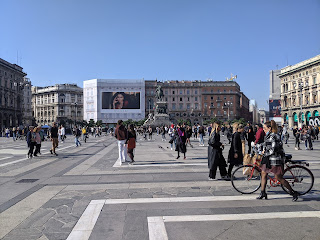



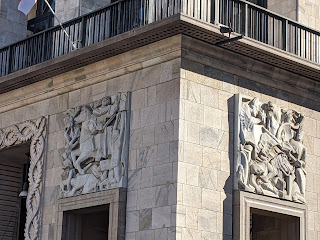












































































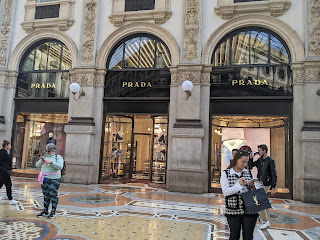



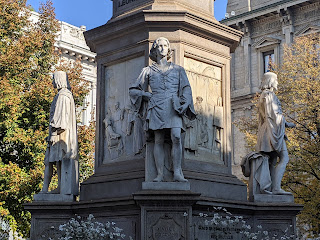






























I too love to find "gargoyle" Drain pipes on buildings. Lovely tapestries. Janina
ReplyDeleteJanina,
ReplyDeleteHappy that you also enjoyed looking at the gargoyles - I'll remember that when we see more of them. I was thrilled to see more of the breathtaking Flemish tapestries that we never saw unfortunately in Belgium.